CHEVROLET CAMARO 1993 Owners Manual
Manufacturer: CHEVROLET, Model Year: 1993, Model line: CAMARO, Model: CHEVROLET CAMARO 1993Pages: 358, PDF Size: 15.6 MB
Page 171 of 358
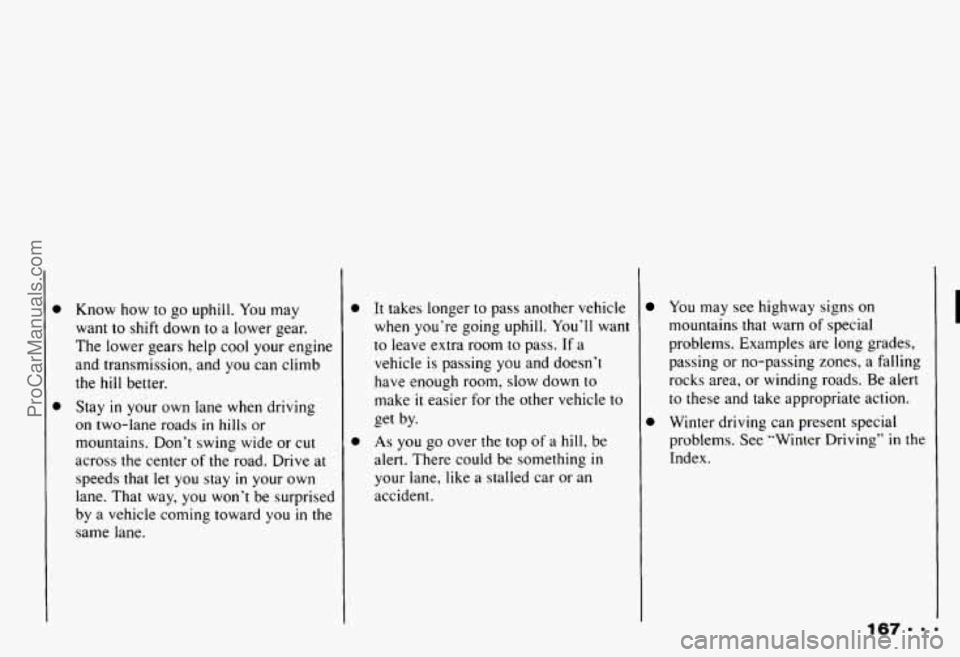
Know how to go uphill. You may
want
to shift down to a lower gear.
The lower gears help cool your engine
and transmission, and
you can climb
the
hill better.
Stay
in your own lane when driving
on two-lane roads in hills or
mountains. Don’t swing wide or cut
across the center of the road. Drive at
speeds that let you stay
in your own
lane. That way, you won’t be surprised
by a vehicle coming toward you
in the
same lane.
It takes longer to pass another vehicle
when you’re going uphill. You’ll want
to leave extra room to pass. If a
vehicle is passing you and doesn’t
have enough room, slow down
to
make it easier for the other vehicle to
get
by.
As you go over the top of a hill, be
alert. There could be something
in
your lane, like a stalled car or an
accident.
0
You may see highway signs on
mountains that warn
of special
problems. Examples are long grades,
passing or no-passing
zones, a falling
rocks area, or winding roads. Be alert
to these and take appropriate action.
Winter driving can present special problems. See
“Winter Driving” in the
Index.
ProCarManuals.com
Page 172 of 358
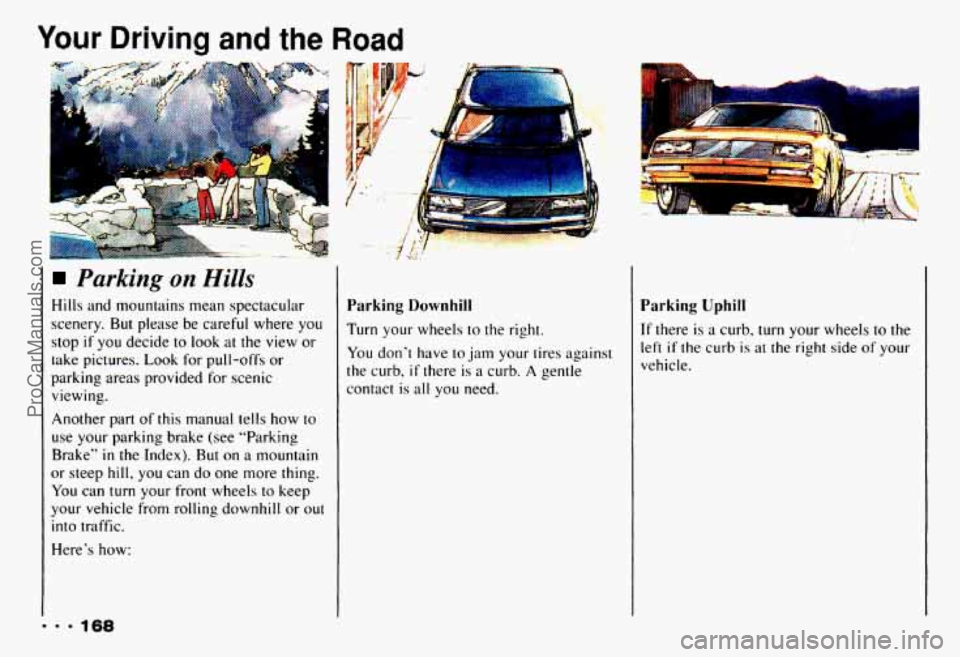
Your Driving and the Road
Parking on Hills
Hills and mountains mean spectacular
scenery.
But please be careful where you
stop
if you decide to look at the view or
take pictures. Look for pull-offs or
parking areas provided for scenic
viewing.
Another part
of this manual tells how to
use your parking brake (see "Parking
Brake"
in the Index). But on a mountain
or steep
hill, you can do one more thing.
You can
turn your front wheels to keep
your vehicle from rolling downhill or out
into traffic.
Here's how:
Parking Downhill
Turn your wheels to the right.
You don't have to jam
your tires against
the curb,
if there is a curb. A gentle
contact
is all you need.
-m
Parking Uphill
If there is a curb, turn your wheels to the
left
if the curb is at the right side of your
vehicle.
ProCarManuals.com
Page 173 of 358
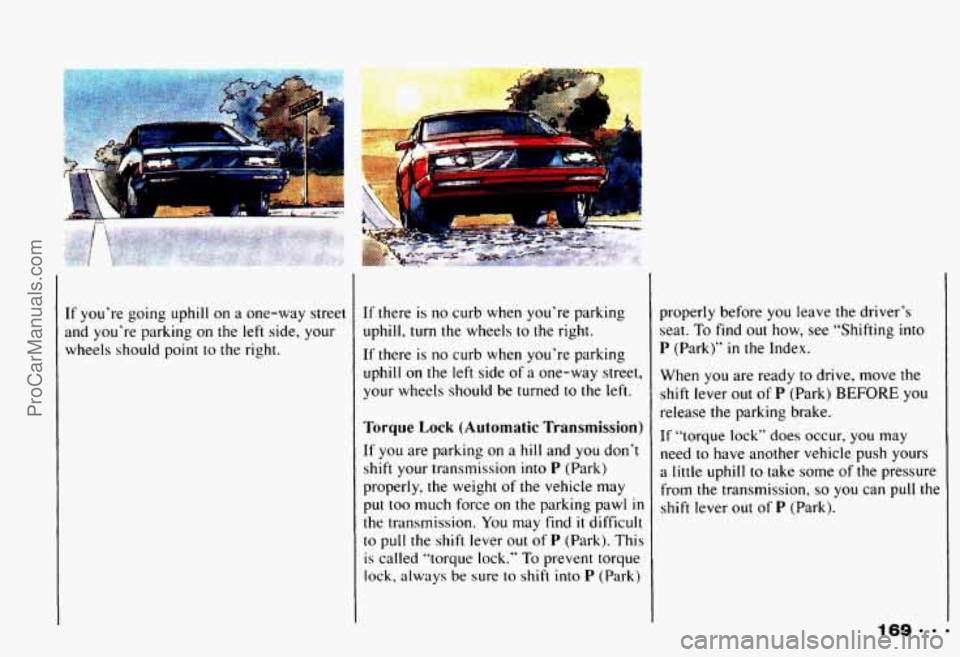
If you’re going uphill on a one-way street
and you’re parking on the left side, your wheels should point to the right. If there is no curb when you’re parking
uphill, turn the wheels
to the right.
If there is no curb when you’re parking
uphill on the left side of a one-way street,
your wheels should be turned to the left.
Torque Lock (Automatic Transmission)
If you are parking on a hill and you don’t
shift your transmission into
P (Park)
properly, the weight
of the vehicle may
put
too much force on the parking pawl in
the transmission. You may find it difficult
to pull the
shift lever out of P (Park). This
is called “torque lock.” To prevent torque
lock, always
be sure to shift into P (Park) properly before
you leave the driver’s
seat.
To find out how, see “Shifting into
P (Park)” in the Index.
When you are ready to drive, move the
shift lever out of
P (Park) BEFORE you
release the parking brake.
If “torque lock” does occur, you may
need to have another vehicle push yours
a little uphill to take some of the pressure
from the transmission,
so you can pull the
shift lever out of
P (Park).
ProCarManuals.com
Page 174 of 358
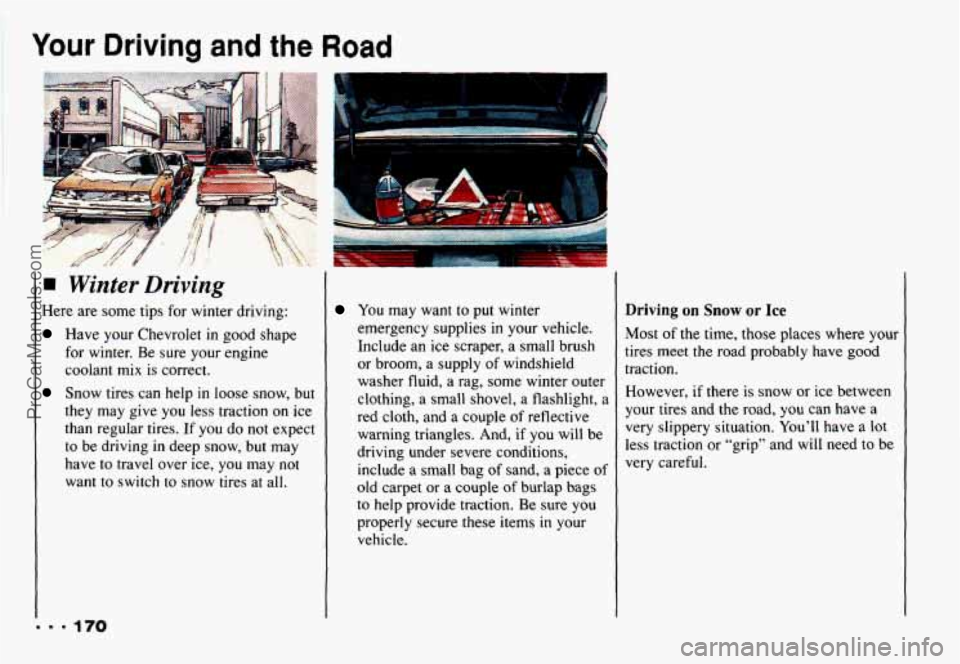
Your Driving and the Road
Winter Driving
Here are some tips for winter driving:
Have your Chevrolet in good shape
for winter. Be sure your engine
coolant mix is correct.
Snow tires can help in loose snow, but
they may give
you less traction on ice
than regular tires.
If you do not expect
to be driving in deep snow, but may
have to travel over ice, you may not
want to switch
to snow tires at all.
You may want to put winter
emergency supplies in your vehicle.
Include an ice scraper, a small brush
or broom, a supply
of windshield
washer fluid, a rag, some winter outer
clothing, a small shovel, a flashlight, a
red cloth, and a couple
of reflective
warning triangles. And, if you will be
driving under severe conditions,
include a small bag of sand, a piece of
old carpet or
a couple of burlap bags
to help provide traction. Be sure you
properly secure these items in your
vehicle.
Driving on Snow or Ice
Most of the time, those places where your
tires meet
the road probably have good
traction.
However, if
there is snow or ice between
your tires and the road, you can have a
very slippery situation. You’ll have a lot
less traction or “grip” and will need to
be
very careful.
ProCarManuals.com
Page 175 of 358
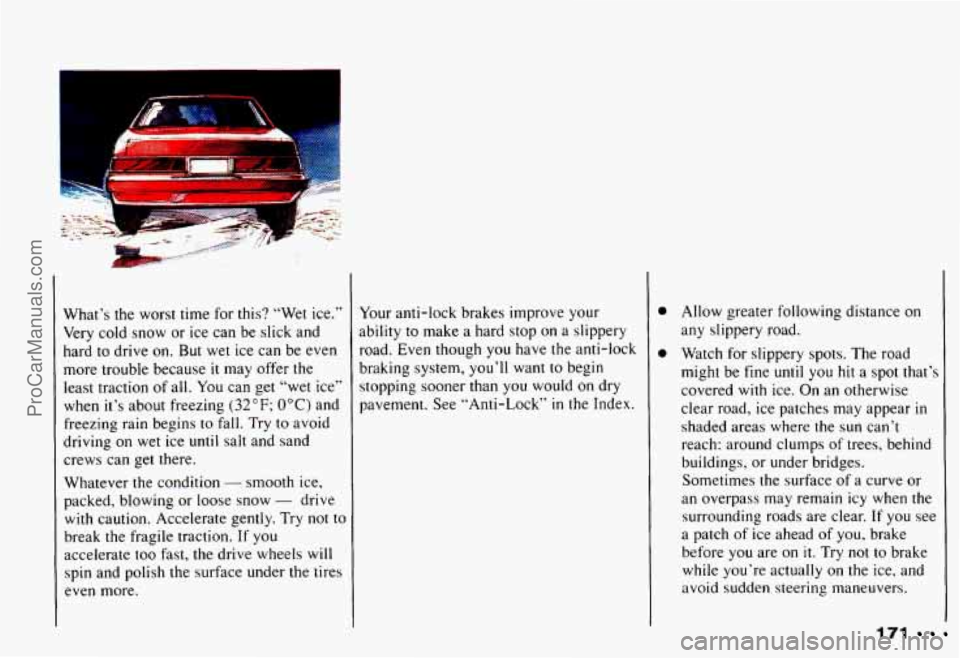
What’s the worst time for this? “Wet ice.”
Very cold snow or ice can be slick and
hard
to drive on. But wet ice can be even
more trouble because
it may offer the
least traction
of all. You can get “wet ice”
when it’s about freezing
(32°F; OOC) and
freezing
rain begins to fall. Try to avoid
driving on wet ice
until salt and sand
crews can get there.
Whatever
the condition - smooth ice,
packed, blowing or loose snow
- drive
with caution. Accelerate gently. Try not to
break the fragile traction. If you
accelerate
too fast, the drive wheels will
spin and polish the surface under the tires
even more. Your
anti-lock brakes improve your
ability
to make a hard stop on a slippery
road. Even though you have the anti-lock
braking system, you’ll want to begin
stopping sooner than you would on
dry
pavement. See “Anti-Lock” in the Index.
0
0
Allow greater following distance on
any slippery road.
Watch for slippery spots. The road
might be fine
until you hit a spot that’s
covered
with ice. On an otherwise
clear road, ice patches
may appear in
shaded areas where the sun can’t
reach: around clumps of trees, behind
buildings, or under bridges.
Sometimes
the surface of a curve or
an overpass may remain icy when the
surrounding roads are clear.
If you see
a patch of ice ahead of you, brake
before you are on
it. Try not to brake
while you’re actually on the ice, and
avoid sudden steering maneuvers.
171
ProCarManuals.com
Page 176 of 358
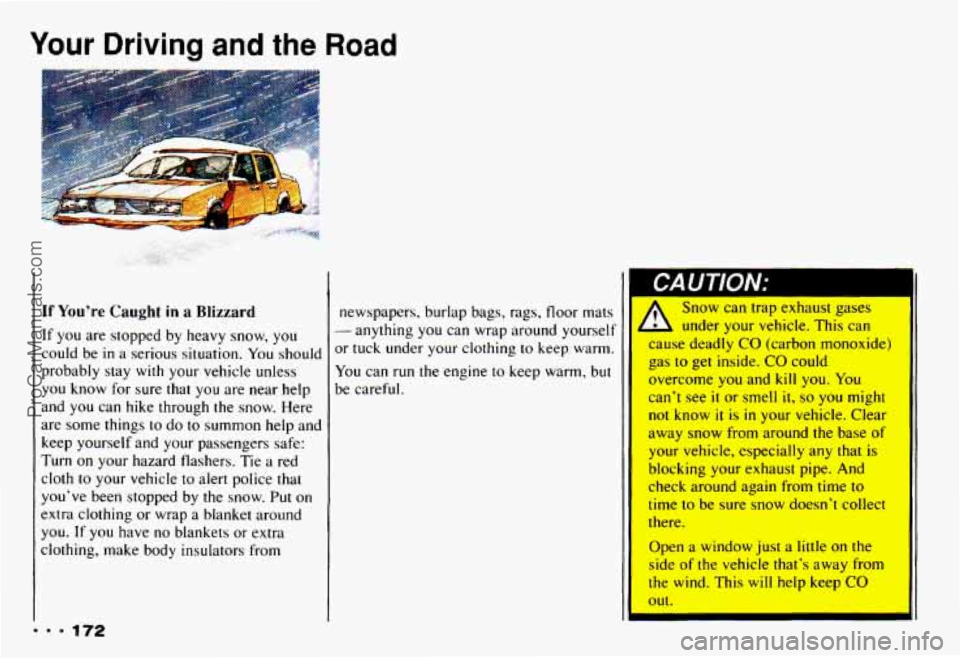
Your Driving and the Road
If You’re Caught in a Blizzard
If you are stopped by heavy snow, you
could be
in a serious situation. You should
probably stay
with your vehicle unless
you know for sure that you are near
help
and you can hike through the snow. Here
are some things to
do to summon help and
keep yourself and your passengers safe:
Turn on your hazard flashers. Tie a red
cloth to your vehicle
to alert police that
you’ve been stopped
by the snow. Put on
extra clothing or wrap a blanket around
you.
If you have no blankets or extra
clothing, make body insulators from newspapers, burlap bags, rags, floor mats
- anything
you can wrap around yourself
or tuck under your clothing to keep warm.
You can run the engine to keep warm, but
be careful. Snow can trap exhaust gases
L under your vehicle.
This can
cause deadly
CO (carbon monoxide)
gas to get inside. CO could
overcome you and
kill you. You
can’t see it or smell it, so you might
not know
it is in your vehicle. Clear
away snow from around the base of
your vehicle, especially any that is
blocking your exhaust pipe.
And
check around again from time to
time
to be sure snow doesn’t collect
there.
Open a window just a little on the
side
of the vehicle that’s away from
the wind. This
will help keep CO
out. I
m.. 172
ProCarManuals.com
Page 177 of 358
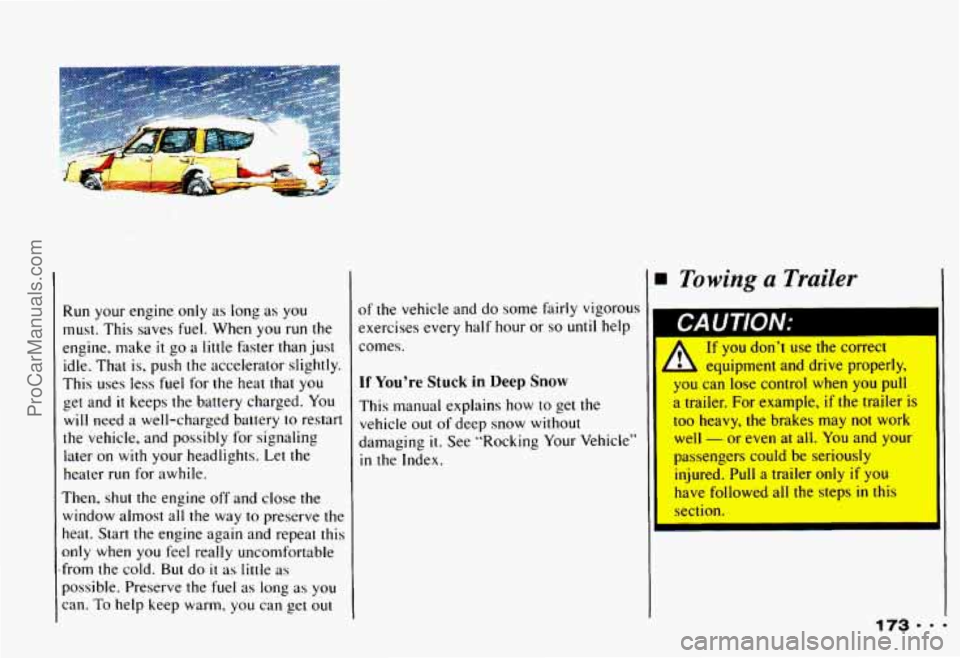
Run your engine only as long as you
must. This saves fuel. When you
run the
engine, make
it go a little faster than just
idle. That is, push the accelerator slightly.
This uses less fuel for the heat that you
get and
it keeps the battery charged. You
will need a well-charged battery to restart
the vehicle, and possibly for signaling
later on
with your headlights. Let the
heater
run for awhile.
Then. shut the engine off and close the
window almost all the way to preserve the
heat. Start the engine again and repeat this
only when you feel really uncomfortable
from the cold.
But do it as little as
possible. Preserve the fuel as long as you
can.
To help keep warm. you can get out
3f the vehicle and do some fairly vigorous
zxercises every half hour or
so until help
Zomes.
If You're Stuck in Deep Snow
This manual explains how to get the
vehicle
out of deep snow without
damaging it. See "Rocking Your Vehicle"
in the Index.
Towing a Trailer
you can lose control when you pull
a trailer. For example, if the trailer is
too heavy, the brakes may not work
well - or even at all. You and your
passengers could be seriously
injured. Pull a trailer only if you
have followed all the steps in this
section.
ProCarManuals.com
Page 178 of 358
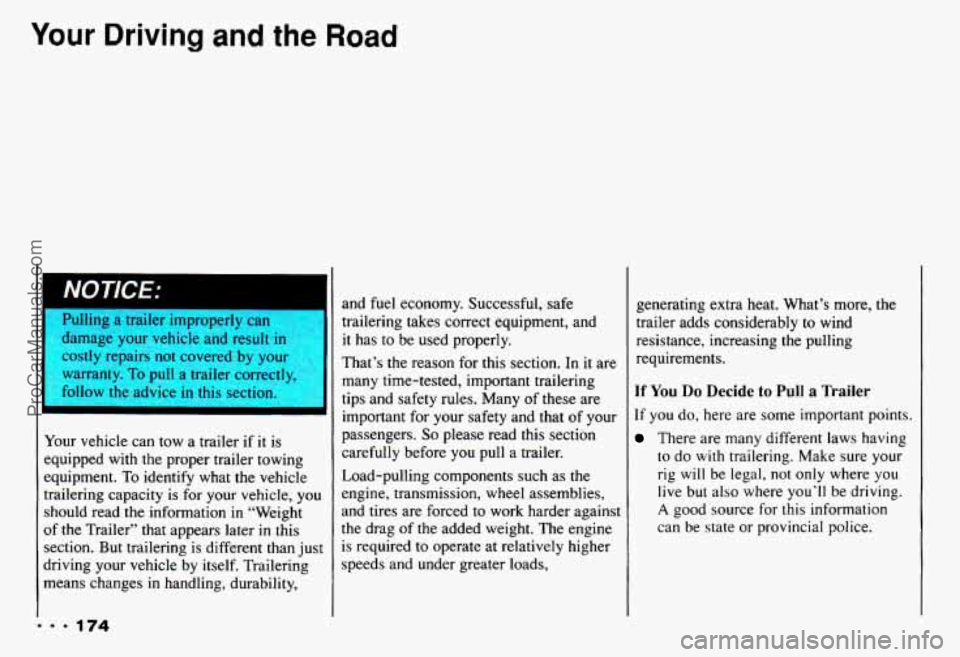
Your Driving and the Road
I NOTICE:
AAtnage your vehicle and result i~
jtly repairs not covered by you.
warranty.
To pull a trailer correctly,
follow the advice
in this section.
I
Your vehicle can tow a trailer if it is
equipped
with the proper trailer towing
equipment.
To identify what the vehicle
trailering capacity
is for your vehicle, you
should read the information in “Weight
of the Trailer” that appears later
in this
section. But trailering is different than just
driving your vehicle by itself. Trailering
means changes
in handling, durability, and fuel economy.
Successful, safe
trailering takes correct equipment, and
it has to be used properly.
That’s the reason for this section, In it are
many time-tested, important trailering
tips and safety rules. Many of these are
important for your safety and that of your
passengers.
So please read this section
carefully before you pull a trailer.
Load-pulling components such as the
engine, transmission, wheel assemblies,
and tires are forced to work harder against
the drag of the added weight. The engine
is required to operate at relatively higher
speeds and under greater loads, generating extra
heat. What’s more,
the
trailer adds considerably to wind
resistance, increasing the pulling
requirements.
If You Do Decide to Pull a Trailer
If you do, here are some important points.
There are many different laws having
to do
with trailering. Make sure your
rig
will be legal, not only where you
live but also where you’ll be driving.
A good source for this information
can be state or provincial police.
ProCarManuals.com
Page 179 of 358
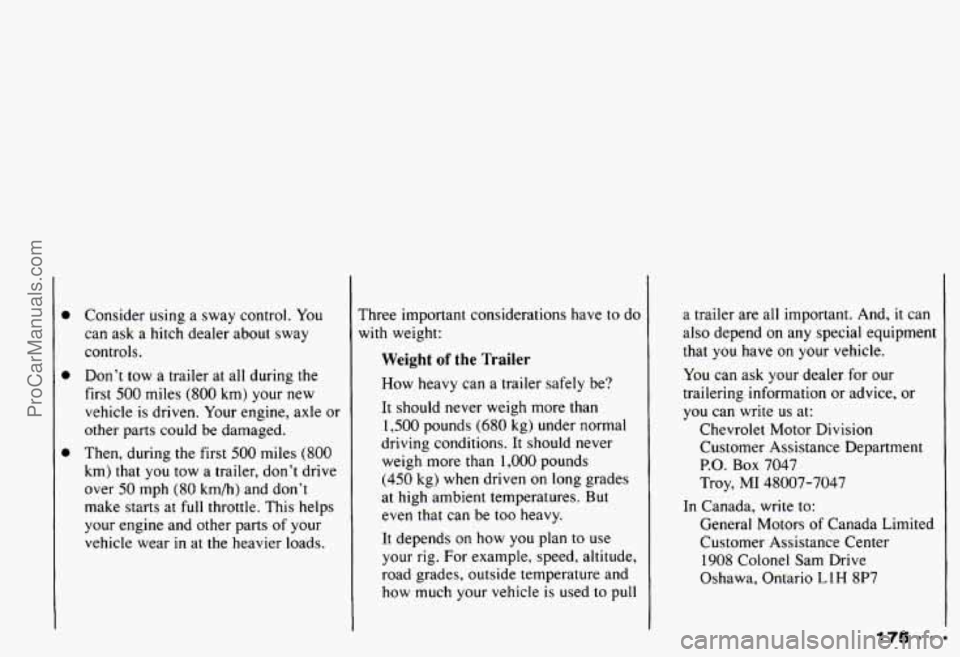
Consider using a sway control. You
can ask a hitch dealer about sway
controls,
Don’t tow a trailer at all during the
first
500 miles (800 km) your new
vehicle is driven. Your engine, axle or
other parts could
be damaged.
Then, during the first
500 miles (800
km) that you tow a trailer, don’t drive
over
50 mph (80 km/h) and don’t
make starts at full throttle. This helps
your engine and other parts of your
vehicle wear
in at the heavier loads. Three
important considerations have to do
with weight:
Weight of the Trailer
How heavy can a trailer safely be?
It should never weigh more than
1,500 pounds (680 kg) under normal
driving conditions. It should never
weigh more than
1,000 pounds
(450 kg) when driven on long grades
at high ambient temperatures. But
even that can be too heavy.
It depends on how you plan to use
your rig. For example, speed, altitude,
road grades, outside temperature and
how much your vehicle is used to pull a
trailer are all important. And,
it can
also depend on any special equipment
that you have on your vehicle.
You can ask your dealer for our
trailering information or advice, or
you can write
us at:
Chevrolet Motor Division
Customer Assistance Department
P.O. Box 7047
Troy, MI 48007-7047
In Canada, write to:
General Motors
of Canada Limited
Customer Assistance Center
1908 Colonel Sam Drive
Oshawa, Ontario
LlH 8P7
ProCarManuals.com
Page 180 of 358
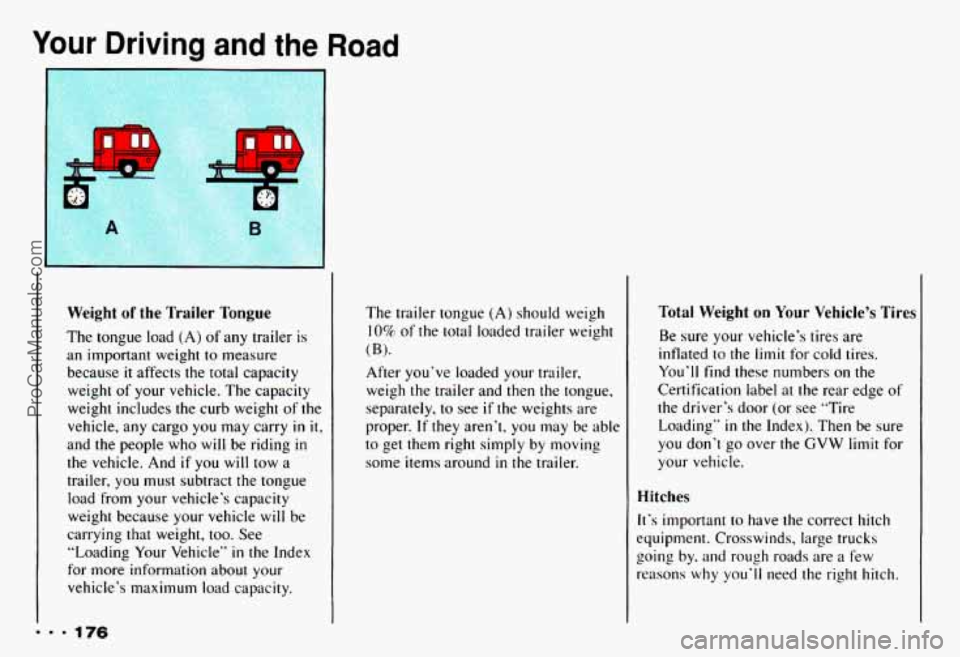
Your Driving and the
Weight of the Trailer Tongue
The tongue load (A) of any trailer is
an important weight to measure because
it affects the total capacity
weight of your vehicle. The capacity
weight includes the curb weight
of the
vehicle,
any cargo you may carry in it,
and the people who will be riding in
the vehicle. And if you will tow a
trailer, you must subtract the tongue load from your vehicle‘s capacity
weight because your vehicle
will be
carrying that weight, too. See
“Loading Your Vehicle”
in the Index
for more information about your
vehicle’s
maximum load capacity.
Road
The trailer tongue (A) should weigh
10% of the total loaded trailer weight
(E).
After you’ve loaded your trailer,
weigh the trailer and then the tongue,
separately, to see
if the weights are
proper.
If they aren’t, you may be able
to get them right simply
by moving
some items around
in the trailer.
Total Weight on Your Vehicle’s Tires
Be sure your vehicle’s tires are
inflated to the
limit for cold tires.
You’ll
find these numbers on the
Certification label at the rear edge of
the driver’s door (or see “Tire
Loading”
in the Index). Then be sure
you don’t go over
the GVW limit for
your vehicle.
Hitches
It‘s important to have the correct hitch
equipment. Crosswinds, large trucks
going
by. and rough roads are a few
reasons
why you’ll need the right hitch.
ProCarManuals.com